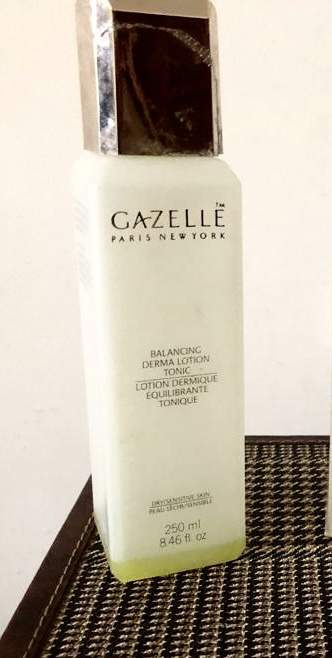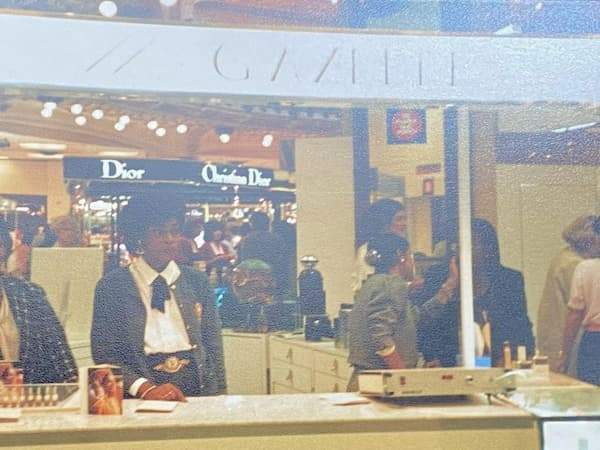🇬🇧 While getting ready to launch this blog, I felt that this was the perfect opportunity to recall a beautiful brand that my aunts in Senegal used to use when I was a child. It always puzzled me that no one ever mentioned it (and a quick Google search confirmed that feeling) when it had been a revolution at the time: a high-end skin-care focused brand, specifically created for black women, at a time when most of the industry’s big names completely ignored our main concerns.
This brand is GAZELLE INTERNATIONAL, created by a young Black American woman living in Paris, Patricia French, and who understands way too early maybe, that the majority of skincare products at that time are not suitable for black women’s specific physiological needs. A mother of pearl box with the word GAZELLE in gold embossed letters, the packaging is luxurious and incredibly elegant. I clearly remember as a little girl thinking that this was going to embody my life as an adult.

A runway model for the House of Chanel to earn extra money when she arrives in Paris in 1979 to study art, Patricia French decides to train as a makeup artist at the prestigious Christian Chaveau school.
Originally from Warner Robins, Georgia, in the United States, she remembers that she always loved cosmetics. “I was always playing in my mom’s makeup bag” she says with a big laugh.
She gets the opportunity to work as a makeup artist in Ivory Coast as soon as she graduates with a group of African First Ladies., She meets Elaine Evans in Abidjan, who’s also a young African American lady doing hair and already living in the West African city. It’s during this trip that Patricia has the idea to create a beauty brand for black women’s distinct beauty issues (splotchy pigmentation, discoloration etc…). But she wants to focus on Skincare rather than Cosmetics which was in high demand from “ethnic” customers then.
Back in Paris, she meets by coincidence (at the gym!) Senegalese biochemist Amal Ayad who already develops products for big French groups such as Lazartigue. An ISIPCA graduate, the French school that trains its students in Cosmetics and Perfumes, Amal is going to formulate incredibly innovative products for the budding company. She definitely feels that they were way ahead of the times when she kindly recounts what her vision was back then.
Many of the products contain sunscreen at a time when many held the misconception that melanin protected skins didn’t need an extra layer against the sun. She also prioritizes ingredients from Africa, GAZELLE was one of the first beauty brand to rely heavily on shea butter back when it wasn’t as ubiquitous. She focuses on pigment imbalance while creating the new range and a few makeup products are added to the lineup. They are formulated to be very light with particular attention to the many undertones that can be seen with black skin. “A lot of the foundations at that time had either yellow or orange undertones. The choice was very limited” Patricia explains. The foundations are very smooth and with a very distinctive range of colours, different from what other brands are doing back then.

It took 18 months of testing and close to a million dollars for GAZELLE to launch. The brand debuted 16 products, mainly skincare. The products are not just sold in the northern hemisphere (in the Galeries Lafayette in Paris, in Nordstrom in Southern California to name a few) but are also available in Cameroon, in Gabon or the Ivory Coast.
In 1986, Patricia French reiterates during the press conference officially launching GAZELLE at the Crillon in Paris how black skins don’t really need “anti-ageing” products. Thanks to the large amounts of melanin in them, black skins don’t really wrinkle. This didn’t sit well with some of the attendants (L’Oreal actually gave a contradictory speech).

Patricia French, a young black woman succeeded in creating a luxury brand for women just like her, formulated by an African biochemist, partially developed on the continent and distributed where no one was going until then.
Soon in need of financing to allow GAZELLE’s development, Patricia encounters reluctance from potential investors. No one really believes that this “ethnic” skincare market will get anywhere. And with mounting cash flow problems, the young woman decides to shut all operations.
Patricia French and GAZELLE walked so that brands like Fenty could run decades later and I am so happy to tell her story and share her vision!
Sound off in the comments if you liked this format and would like to hear more brand origin stories, do you remember seeing GAZELLE products?
© N’Deye S. Somparé
GAZELLE COSMÉtiques, les précurseurs
🇫🇷 En me préparant à lancer ce blog, je me suis dit que ce projet était l’occasion parfaite de retrouver une marque absolument magnifique que mes tantes utilisaient lorsque j’étais toute petite au Sénégal. J’étais intriguée par le fait que personne ne la mentionnait plus du tout (et mes recherches sur Google vinrent conforter ce sentiment) alors qu’elle avait été une vraie révolution pour l’époque: une marque haut de gamme, centrée sur les préoccupations des femmes noires alors qu’ à ce moment là, nous sommes complètement ignorées par les mastodontes du secteur.
Cette marque c’est GAZELLE INTERNATIONAL, créée par une jeune Afro-Américaine instalée à Paris, Patricia French, et qui comprend très tot (trop tot) que la plupart des produits de beauté ne sont pas adaptés aux besoins spécifiques des peaux noires. Un écrin blanc nacré avec le mot GAZELLE en lettres d’or et en relief, un packaging luxueux et d’une élégance folle, je me rappelle clairement ces objets de désir pour la petite fille que j’étais
Mannequin chez Chanel après avoir débarqué à Paris en 1979 pour y étudier l’art, Patricia French la bien nommée, décide de se former au maquillage à la prestigieuse école de maquillage Christian Chaveau.
Native de la ville de Warner Robins en Géorgie aux Etats-Unis, elle se souvient d’avoir toujours été très attirée par les cosmétiques. “J’étais toujours fourrée dans la trousse de maquillage de ma mère” me confie-t-elle dans un grand éclat de rire.
Son diplome en poche, elle a l’opportunité de se rendre en Cote d’Ivoire afin d’y maquiller un groupe de premières dames Africaines. Elle y rencontre Elaine Evans, une jeune coiffeuse noire américaine qui y est installée. C’est là que va germer l’idée de créer une marque à destination des femmes noires et qui réponde aux besoins particuliers des peaux riches en mélanine. Une marque, cependant, qui ne soit pas centrée sur le maquillage contrairement à ce qui dominait le marché alors.
De retour à Paris, elle rencontre par le plus grand des hasards (dans une salle de gym!) une jeune chimiste d’origine Sénégalaise, Amal Ayad, qui travaille déjà pour de grands groupes Français tels que Lazartigue. Diplomée de l’ISIPCA de Versailles, une formation spécialisée en Cosmétique et Parfumerie, Amal va formuler des produits incroyablement innovants. Elle ne dit pas autre chose lors de la conversation qu’elle m’a gracieusement accordée.” Nous étions beaucoup trop en avance sur notre temps”
Beaucoup des produits par exemple, contiennent des filtres UV. L’idée que meme les peaux riches en mélanine ont aussi besoin de se protéger du soleil n’est alors pas encore très répandue. Elle fait aussi en sorte d’utiliser des matières premières en provenance de l’Afrique tel que le beurre de karité dont l’omniprésence dans nos produits aujourd’hui n’en est alors qu’à ses balbutiements. La réduction des taches pigmentaires est le point focal de ces formulations et les quelques produits de maquillage qui accompagnent le lancement de la marque seront extremement légers avec une attention particulière apportée aux multiple sous-tons qui caractérisent les peaux noires.
“La plupart des fonds de teint avaient soit des sous-tons jaunes soit des sous-tons oranges. Le choix était très limité” explique Patricia.
Les fonds de teint sont veloutés avec des couleurs très distinctes à contre courant de ce qui se fait alors.
Dix-huit mois de recherche et près d’un million de dollars sont investis avant que ne voit le jour la marque GAZELLE. La marque débute avec 16 produits dans un premier temps. Loin de se contenter de n’être vendue que dans les grandes capitales occidentales, GAZELLE est aussi distribuée au Cameroun, au Gabon ou encore en Cote d’Ivoire.
En 1986, Patricia French réaffirme lors de la conference de presse de lancement de GAZELLE au Crillon à Paris, les différences fondamentales des peaux noires, de leur protection fournie par la mélanine qui fait des produits anti-age si chers à l’industrie cosmétique traditionnelle des produits non-prioritaires dans le domaine de la beauté dite “ethnique”. Elle provoque alors beaucoup de grincements de dents.
Patricia French, jeune femme noire, a réussi à créer une marque de luxe destinée aux femmes comme elle, formulée par une chimiste Africaine, développée en partie sur le continent et distribuée là où personne ne s’intéressait à aller jusque là.
Ayant besoin de financements afin d’assurer l’expansion de GAZELLE, Patricia rencontre beaucoup de réticences. Personne à ce moment là, n’estime ce marché très porteur et peu à peu, faute d’investisseurs et avec une trésorerie de plus en plus défaillante, la jeune femme doit se résoudre à interompre l’aventure.
Mais elle a ouvert la brèche dans laquelle vont s’engouffrer quelques décennies plus tard des marques telles que Fenty.
Dites moi dans vos commentaires si vous avez aimé cet article et si vous aimeriez plus d’histoires comme celles ci sur l’origine des marques! Est-ce que parmi vous certaines se rappellent GAZELLE?
© N’Deye S. Somparé



Leave a Reply